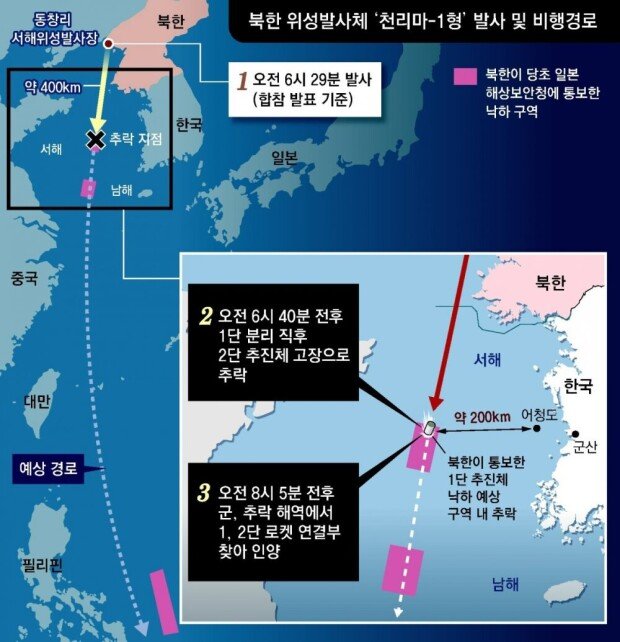N. Korea’s spy satellite fails during second stage propulsion
N. Korea’s spy satellite fails during second stage propulsion
Posted June. 01, 2023 07:40,
Updated June. 01, 2023 07:40


On Wednesday, North Korea launched a long-range ballistic missile disguised as a “space launch vehicle” from the Sohae Satellite Launching Ground in Dongchang-ri, Cholsan County, North Pyongan Province. The missile ultimately landed in waters approximately 200 kilometers west of Eocheong, a southwestern island of South Korea located in the South Korea-China Interim Measures Zone, about 400 kilometers away in a straight line from the launch site. This landing location is significantly distant from the expected fall area of the first-stage booster, which was projected to be up to 300 kilometers southwest of Daecheon port in South Chungcheong Province that North Korea had initially notified the Japan Coast Guard and the International Maritime Organization of.
The projectile traveled a mere one-eighth of the maximum distance of 3,100 kilometers in a straight line from the projected landing zone of the second-stage booster, which is the eastern side of the Philippine Sea. Today’s unsuccessful launch represents the North’s first failure in satellite system tests in seven years since the launch of Kwangmyongsong-4 in February 2016 and the first failure in satellite launches in eleven years since the launch of Kwangmyongsong-3 in April 2012.
The launch vehicle carrying its first military reconnaissance satellite was launched at 6:29 a.m. (North Korea said 6:27 a.m.) and plunged into the West Sea at 6:40 a.m., approximately 10 minutes after the launch. “[The rocket] lost propulsion due to an abnormal engine startup on the second stage after the first stage was separated during normal flight,” the North’s state-run news agency said. The failure is seemingly attributable to the malfunctioning of the second-stage engine, failing at ignition and leading to a rapid decline of the thrust of the launch vehicle, which resulted in uncontrolled flight until it crashed off the western coast of the Korean Peninsula.
Considering North Korea’s reference to the “instability in the fuel system,” it is possible that the North adjusted the fuel ratio, ultimately leading to the failure. The analysis indicates that a liquid-fueled engine modified from the Hwasong-15 and Hwasong-17 intercontinental ballistic missile (ICBM) was utilized in the attempted launch of a reconnaissance satellite, exposing underlying technical issues.
At approximately 8:05 a.m., the South Korean military recovered a large cylindrical object floating in the sea roughly 200 kilometers off the west coast island of Eocheong Island after 1 hour and 40 minutes from the launch of what is believed to be a suspected rocket component. “As soon as North Korea informed the Japan Coast Guard of the launch, we promptly initiated our preparedness measures, dispatching vessels such as the Tongyeong salvage and rescue ship to the anticipated landing area of the first-stage vehicle,” stated a South Korean military official.
Sang-Ho Yun ysh1005@donga.com · Hyo-Ju Son hjson@donga.com







